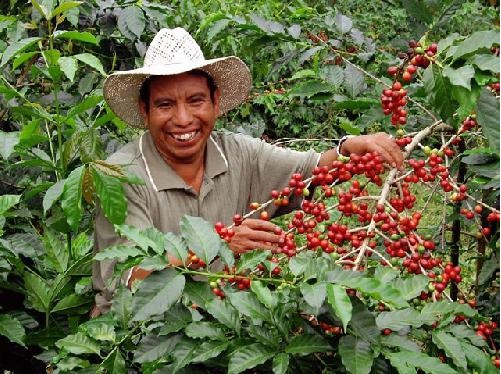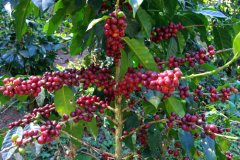Coffee characteristics, uses and Coffee producing areas in Guatemala & output, production and Marketing of Coffee products over the years

For professional baristas, please follow the coffee workshop (Wechat official account cafe_style)
Guatemala is located in the north of Central America, bordered by Mexico to the west and north, Belize and the Caribbean to the east, Honduras and El Salvador to the southeast, and the Pacific Ocean to the south. Terrain: the terrain of Guatemala changes obviously and can be divided into three parts:
Northern lowland: peat é n area, below 200m above sea level, is limestone geology, mostly undeveloped tropical forests, rich in forest resources and sparsely populated, including the famous Mayan cultural relic-Tikal.
The average height of the central alpine region is between 1000 and 2000 meters: the mountain ranges from southwest to southwest, with volcanic belts to the southwest. A series of volcanoes stand with peaks ranging from 3000 to 4000 meters, which are characteristic of the Guardian landscape. During this period, volcanoes and lakes are intertwined. The scenery is beautiful, and more than 5 million Mayan native Indians are scattered.
Pacific coastal plain: it is a volcanic alluvial plain with fertile soil and is the main agricultural production area of the country.
Guatemala is one of the leading coffee suppliers in the world.
Coffee characteristics
Coffee beans are a commodity in global trading volume second only to crude oil. The rise and fall of prices are related to the political and economic stability of coffee-producing countries. For decades, coffee beans have been the most speculative commodity in the world. Generally speaking, it takes two to three years for coffee trees to bear fruit and five to six years for coffee to be harvested. Therefore, it is suitable for small farmers with limited funds to operate and avoid investment risks and losses.
There are about 40 varieties of coffee beans in the world, the common coffee ARABICA coffee grows in high altitude areas, the flavor is more rich, is a better coffee variety, ROBUSTA coffee grows in low altitude areas, easier to grow, caffeine content is also higher.
Coffee use
Coffee is used as a beverage. Most of the ground coffee used in Europe and the United States is ARABICA coffee, while ROBUSTA coffee is mainly made into instant coffee, which is a relatively cheap coffee.
Coffee producing area & output
Coffee is widely distributed in South America, Central America, the West Indies, Asia, Africa, Arabia, the South Pacific and Oceania. In terms of production, Brazil ranks first in the world, accounting for about 1/3 of the world, followed by Colombia, accounting for about 15 per cent of the world, followed by Africa (including C ô te d'Ivoire, Uganda, Kenya, etc.), Arabia, and distributed in Asian countries and islands.
ARABICA coffee is mainly produced in Brazil, Colombia, Mexico, Guatemala Mara, El Salvador, Honduras, Costa Rica, Nicaragua and other countries, mainly concentrated in Central and South America, Brazil is the most important producer of ARABICA coffee.
ROBUSTA coffee production is concentrated in Southeast Asia, Indonesia, Vietnam, Thailand, India and other countries.
Coffee supply & demand
Most of the coffee importing countries are developed countries, and the largest coffee importing countries in the world are the United States, Germany, Japan, South Korea, France and other countries, accounting for about half of the global coffee consumption. In addition, Brazil is also a major consumer, with annual per capita coffee consumption close to that of European countries.
The main exporters of coffee are Brazil, Colombia, Vietnam, Indonesia, Mexico, Uganda and other developing countries. As the trade barriers to coffee are lower than those of other agricultural products, and international organizations also encourage developing countries to grow coffee, poor countries are allowed to join the cultivation process.
Factors affecting the price of coffee
1. Climate, diseases and insect pests in the producing area
two。 Seasonal factors
3. International demand and supply
4. Government policies and International Coffee Organization measures
General situation of production and Marketing of Coffee products in Guatemala over the years
Year
Output
Unit: thousand packs (60kg each)
Export volume
Unit: thousand packs (60kg each)
Consumption
Unit: thousand packs (60kg each)
Year 2001
3530
3330
four hundred and twenty
2002
3802
3500
four hundred and twenty
2003
3671
3314
four hundred and twenty four
2004
3817
3451
three hundred and seventy
2005
3715
3325
three hundred and eleven
2006
4050
3980
two hundred and seventy
2007
4110
3890
three hundred and forty
2008
3980
3783
three hundred and sixty
2009
4010
3890
three hundred and forty
2010
3960
3725
four hundred and twenty five
2011
4410
3915
six hundred
2012
4210
3800
five hundred
2013
3885
3500
six hundred
2014
2015
2016
Important Notice :
前街咖啡 FrontStreet Coffee has moved to new addredd:
FrontStreet Coffee Address: 315,Donghua East Road,GuangZhou
Tel:020 38364473
- Prev

Visit the Guatemalan Coffee Manor to witness the process of Guatemalan coffee from seed to cup of coffee
For the exchange of professional baristas, please pay attention to the coffee workshop (Wechat official account cafe_style) basic data of the Republic of Guatemala ● area of Japan 1ram 3 Capital Guatemala City language Spanish Mayan nationals GDP 250,000 yen per person (year) 2009 members of the Guatemalan delegation include Mr. Matsuwon Coffee of Matsuwon Coffee Co., Ltd., Mr. Moji of Old New Co., Ltd.
- Next

An introduction to the five major coffee producing areas in Guatemala
Professional barista communication please follow the coffee workshop (Wechat official account cafe_style) Guatemala coffee beans smell like peanut biscuits, very special, this time also brewed two rounds, the result is the second time to win, notes are as follows: Guatemala 1 first bean grinder tiamo700s scale 4, grind 16 grams of powder, 200CC water, water temperature 88 C, pour 200CC water into
Related
- Detailed explanation of Jadeite planting Land in Panamanian Jadeite Manor introduction to the grading system of Jadeite competitive bidding, Red bid, Green bid and Rose Summer
- Story of Coffee planting in Brenka region of Costa Rica Stonehenge Manor anaerobic heavy honey treatment of flavor mouth
- What's on the barrel of Blue Mountain Coffee beans?
- Can American coffee also pull flowers? How to use hot American style to pull out a good-looking pattern?
- Can you make a cold extract with coffee beans? What is the right proportion for cold-extracted coffee formula?
- Indonesian PWN Gold Mandrine Coffee Origin Features Flavor How to Chong? Mandolin coffee is American.
- A brief introduction to the flavor characteristics of Brazilian yellow bourbon coffee beans
- What is the effect of different water quality on the flavor of cold-extracted coffee? What kind of water is best for brewing coffee?
- Why do you think of Rose Summer whenever you mention Panamanian coffee?
- Introduction to the characteristics of authentic blue mountain coffee bean producing areas? What is the CIB Coffee Authority in Jamaica?

